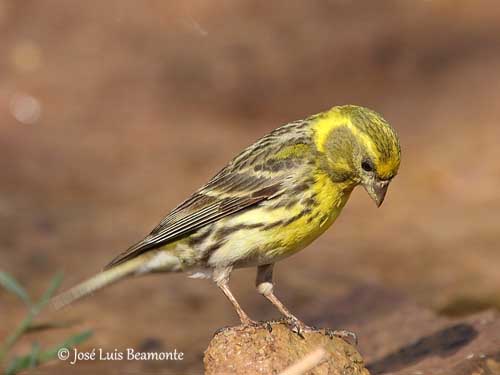
Fr: Serin cini
All: Girlitz
Esp: Verdecillo
Ital: Verzellino europeo
Nd: Europese Kanarie
Sd: Gulhämpling
Photographers:
José Luis Beamonte
Pájaros de España
Ingo Waschkies
Bird Photography
Nicole Bouglouan
PHOTOGRAPHIC RAMBLE
Text by Nicole Bouglouan
Sources:
HANDBOOK OF THE BIRDS OF THE WORLD Vol 15 by Josep del Hoyo-Andrew Elliot-David Christie - Lynx Edicions – ISBN: 9788496553682
ENCYCLOPEDIE DES OISEAUX DE FRANCE ET D’EUROPE – de Peter Hayman et Rob Hume - Flammarion – ISBN : 2082009920
Ottaviani, M. (2008) Monographie des Fringilles (fringillinés – carduélinés) – Histoire Naturelle et photographies, Volume 1. Editions Prin, Ingré, France, 488 p.
THE HANDBOOK OF BIRD IDENTIFICATION FOR EUROPE AND THE WESTERN PALEARCTIC by Mark Beaman, Steve Madge - C.Helm - ISBN: 0713639601
BirdLife International (BirdLife International)
XENO-CANTO – Sharing Birds sounds from around the world
European Serin
Serinus serinus
Passeriforme Order – fringillidae Family
BIOMETRICS:
Length: 11-12 cm
Weight 8,5-14 g
DESCRIPTION:
The European Serin is a small, compact bird. This species is the smallest Fringillidae of Europe, closely related to the Island Canary (Serinus canaria).
The adult male has streaked dull yellowish-green and dull dark brown upperparts with bright yellow or greenish-yellow rump. The uppertail-coverts and the tail are dark brown, and the rectrices show fine yellowish edges.
The upperwing shows pale tips on median and greater coverts, forming two wingbars. The flight feathers are dark brown with fine pale edges.

On the underparts, chin, throat and breast are bright yellow. Belly, vent and undertail-coverts are white. Breast side and flanks are streaked black.
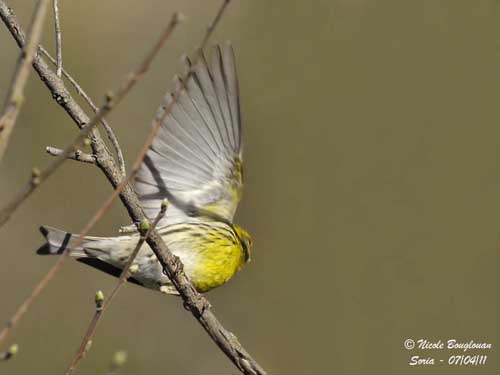
On the head, forehead and forecrown are bright yellow, extending along the supercilium, and down behind the ear-coverts to the neck side. Cheeks, ear-coverts and moustachial stripe are greyish-olive. There is a small subocular yellow patch. Crown and nape are yellowish-green with fine darker streaks.
The short bill is brown or dark horn with paler lower mandible. The eyes are dark brown. Legs and feet are pinkish-brown.
The female resembles male but she has duller plumage with heavier streaking overall. She has narrower supercilium and paler rump.
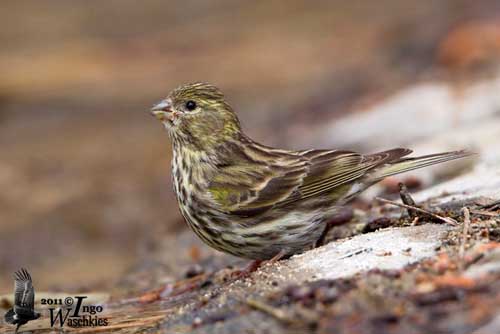
The juvenile is browner than female, with broadly streaked upperparts and whitish underparts with weak streaking.
VOICE: SOUNDS BY XENO-CANTO
The European Serin’s typical call is a loud, trilled twittering “trirrlilit” mainly uttered while flying, and used as contact call between mates. We can also hear a sharp, descending “ch-ik-ik-ik-ik-ik-ik-si-see”.
The alarm call is a high-pitched “tsooee” or “tsswee”.
The song is given from exposed perch or in flight. This is a prolonged, wheezy, chirping, a rapid mixture of melodious and high-pitched notes and short buzzy trills.
The male usually sings all year round, but mainly during the breeding season.
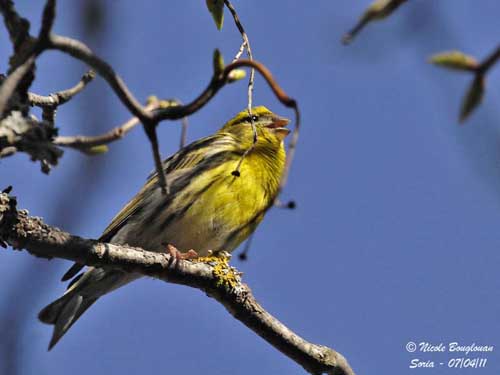
HABITAT:
The European Serin frequents woodland edges and clearings, open cultivated areas, tall hedges, orchards, plantations, urban parks and gardens. This species can be seen in large cities and towns. It is also found in ravines and gorges where there are trees and shrubs.
The European Serin can be seen from sea-level to mountains, up to 2000-2500 metres of elevation.
RANGE:
The European Serin breeds in Europe except the British Islands, E to Baltic and W Russia, S to Mediterranean islands and southern Europe, Lebanon and Israel.
It winters in SW and S Europe and N Africa, and also Iraq.
BEHAVIOUR:
The European Serin feeds on plant matter and small invertebrates. It takes seeds and buds from several plant species and also flowers. Invertebrates include insects and moth larvae, and spiders.
Unlike numerous bird species, it feeds the chicks with seeds.

It forages actively on the ground in bushes and small trees. It walks on the ground or makes short hops. It uses the feet to hold the plant while extracting the seeds with the bill. It plucks petals at flowering bushes before to extract the seeds from the flower heads.
The European Serin may forage alone or in pairs and in small groups outside the breeding season, and even in large flocks with other finches at food sources.
At the beginning of the breeding season, the male performs courtship displays. We can see it in upright stance with drooped and quivering wings, the tail raised and head up. It sings loudly close to the female, turning the head from side to side. The throat feathers are ruffled and its body id slightly trembling.
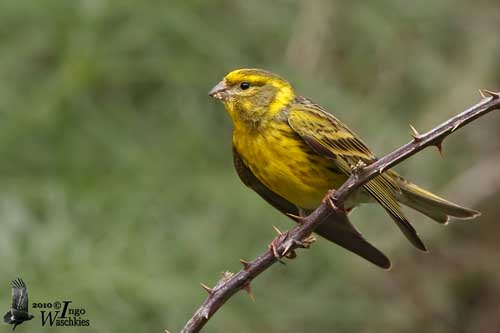
It sings from perch and performs flight displays, a twisting or rolling song-flight performed with slow wing-beats over the territory. Then, it descends in slow parachute-drop and returns to perch close to the female. The repeated displays, singing and song-flight, lead to aerial chases of female by male and copulation.
The European Serin is resident and migratory according to the range. Populations of C Europe move to SW and SE to winter in S Europe, around Mediterranean Basin. The birds of the mountains reach lower areas too. Populations of S Europe are largely sedentary or move short distances after the breeding season.

FLIGHT:
The European Serin has short rounded wings. The flight is fast and undulating, with flapping flight interspersed with glides on closed wings.
REPRODUCTION:
The breeding season occurs between February and early August. This species produces a single brood, but often two in C Europe. This species is monogamous. It breeds solitary, but sometimes several pairs may form loose groups.
The female builds the nest assisted by the male and its collection of materials. The nest is a small, compact platform made with small twigs, stems and down, pieces of bark, roots, grasses, moss, feathers and animal hair. It is placed at about 3-6 metres above the ground, in outermost branches or against the trunk, in crown in tree or bushes.
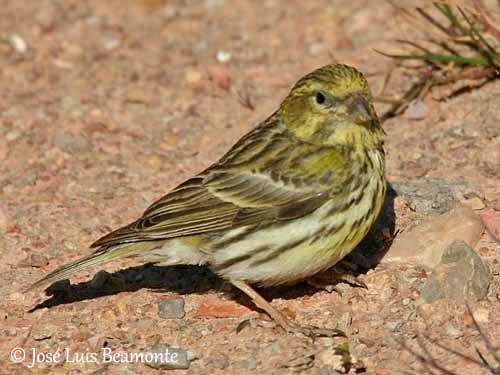
The female lays 3-4 pale eggs with fine dark markings. The female incubates alone during 12-13 days. The chicks are fed by both adults but during the first days, the male regurgitates the food to the female. The young fledge 15-18 days after hatching, and are independent 9-10 days after leaving the nest.
DIET:
The European Serin feeds mainly on seeds, buds, shoots and flowers of numerous plant species. It also consumes small invertebrates such as Aphididae and moth larvae, and spiders. The chicks are fed with seeds.
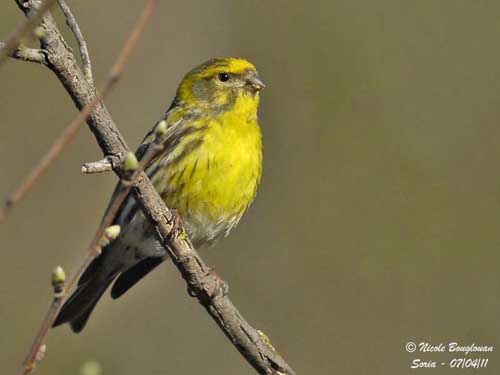
PROTECTION / THREATS / STATUS:
The European Serin is preyed upon by Common Magpie (Pica pica), crows and cats. Bad weather and habitat loss due to agriculture expansion may cause the loss of clutches.
However, this species is common or locally common, and not currently threatened.
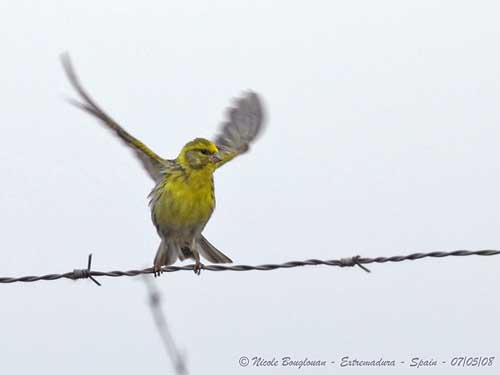
(15 pictures)